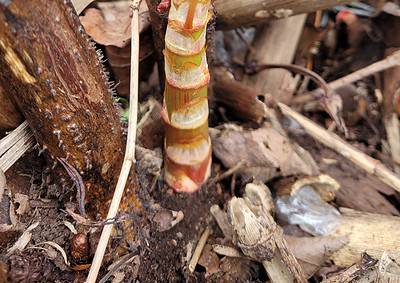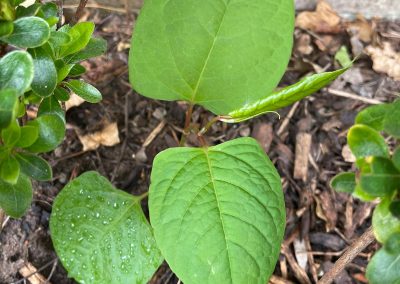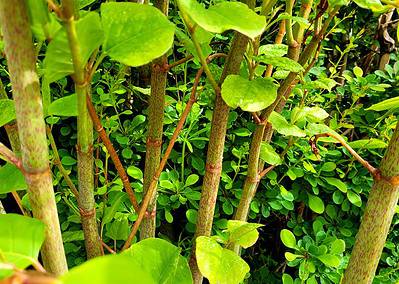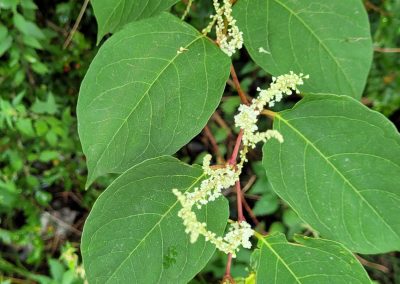Do you think you have discovered Japanese Knotweed on your property I can offer you a Free Japanese Knotweed Survey* that is PCA-Accredited & Mortgage friendly
By using me to carry out your Japanese Knotweed survey you can benefit from all of the below
Free Japanese Knotweed survey if you require a treatment plan*.
Receive your report on the same day as your survey.
The survey and report cost only £180.00*.
3 to 5-year Payment plans available for the treatment* I do not charge VAT.
Free 10-year insurance-backed guarantee with a domestic 5-year treatment plan.
Can you see your suspect plant below?
If your concerned about Japanese knotweed on your property? I can offer a free survey across Manchester, Cheshire, Northwest, and Birmingham. Furthermore being PCA-Accredited I can assess your property and provide a Mortgage-friendly Japanese Knotweed survey report. Call me on 07753682333 to schedule your free survey!
Surprisingly, 85% of Japanese Knotweed Surveys concluded that no Japanese knotweed is present and no further action is required.
Often, conveyancing surveyors request a Japanese Knotweed Survey upon noticing dense vegetation in the garden. Subsequently, lenders will insist on a thorough inspection by a specialist company to assess the garden and its surroundings for any potential presence of Japanese knotweed. If no Japanese knotweed is found on the property at the end of the survey report, it will state that no further actions are required.
I can determine if you require a Japanese knotweed Survey
Photo: click this link to forward your photos to my email. I will identify if it is Japanese knotweed. Nine times out of Ten it’s not Japanese knotweed, and you won’t require a Japanese knotweed survey.
If your conveyancing surveyor states in his report that you must have a Japanese knotweed survey, you can call and arrange this.
The Japanese knotweed Survey can usually be carried out the next day, and you can receive your report the same day as the survey*.
What’s involved in a Japanese Knotweed Survey
A Japanese knotweed survey typically involves thoroughly inspecting a property or area to identify the presence of Japanese knotweed, an invasive plant species. The survey is usually done by qualified professionals such as ecologists, surveyors, or environmental consultants. Here are the critical steps involved in a Japanese knotweed survey:
Initial Assessment:
The Japanese Knotweed survey begins with an initial assessment of the property or area to determine the likelihood of Japanese knotweed presence based on historical records, nearby infestations, and habitat suitability.
Site Inspection:
Qualified surveyors conduct a detailed inspection of the site, examining areas where Japanese knotweed is most likely to grow, such as waste ground, railway embankments, riverbanks, and disturbed soil.
Identification:
Surveyors identify Japanese knotweed plants and distinguish them from other similar-looking plants. Japanese knotweed typically has distinctive bamboo-like stems, heart-shaped leaves, and clusters of small white flowers.
Mapping:
The location and extent of Japanese knotweed infestations are accurately mapped using GPS or other mapping techniques. This information is crucial for creating management plans and determining the appropriate treatment methods.

Assessment of Risk and Damage:
The surveyors assess the risk posed by Japanese knotweed to the property and surrounding ecosystems. This includes evaluating the potential for structural damage to buildings, infrastructure, and drainage systems and the impact on native plant species and biodiversity.
The Royal Institution of Chartered Surveyors (RICS)
The New RICS 2022 guidance introduced a more nuanced approach to assessing the risk from Japanese knotweed compared to previous guidelines. Previously, Japanese knotweed within 7 meters of a residential property could significantly impact the property’s value and potentially affect mortgage ability. However, the latest guidance acknowledges that the impact of Japanese knotweed on buildings is less significant than once feared, leading to a more measured approach to its management.
Critical aspects of the RICS 2022 guidance on Japanese knotweed include:
Risk Categories:
The guidance outlines new risk categories that assess the presence of Japanese knotweed. This is done in a way that is intended to help homeowners, buyers, and professionals. Helping to make more informed decisions. These categories are designed to assess the actual risk to the property rather than automatically assuming significant detriment.
Assessment and Professional Judgment:
The guidance emphasizes the importance of professional judgment in assessing the risk posed by Japanese knotweed. It includes considering the distance of the plant from buildings or structures, the maturity of the infestation, and the potential for future spread.
The guidance recommends preparing a management plan for properties affected by Japanese knotweed. This plan should detail the methods for controlling or eradicating the plant and monitoring strategies to ensure its effective management over time.
Implications for Property Sales and Mortgages:
The updated guidance has implications for the sale of properties and the granting of mortgages. Lenders may be more willing to provide mortgages on properties affected by Japanese knotweed if a professional assessment and a suitable management plan are in place.
The RICS 2022 guidance
Reflects a shift towards a more evidence-based understanding of the risks posed by Japanese knotweed, moving away from the previously more alarmist views. It aims to facilitate more reasonable responses to the presence of the plant, ensuring that control measures are proportionate to the actual risk it poses.
The RICS (Royal Institution of Chartered Surveyors) guidance on Japanese knotweed categorizes.
The risk associated with the plant’s presence near properties into four categories: A, B, C, and D. These categories are designed to help property professionals, including surveyors and mortgage lenders. Assess the potential impact of Japanese knotweed on residential properties. Here is an overview of what each category represents:
Monitoring and Follow-up: In some cases, follow-up monitoring surveys may be conducted to track the effectiveness of control measures and ensure that Japanese knotweed infestations are adequately managed over time.

Although we have the chart above as guidance.
Some Mortgage lenders will still insist on a management plan and insurance-backed guarantee due to misinformation on the internet. Even when the Japanese Knotweed is not causing any problems and may be in Category D.
Interestingly,
One Leader told me they were buying the property, not my client. They would only lend on the property if a 5-year treatment plan was implemented to treat the Japanese Knotweed. (the plants were more than 10 meters from the boundary)
Recommendations:
Based on the survey findings, recommendations are provided for managing and controlling Japanese knotweed infestations. This will be herbicide treatment and ongoing monitoring.
Report:
A detailed survey report is prepared, documenting the findings. Mapping data, risk assessment, and recommendations for management and control. This report is typically provided to the property owner or relevant stakeholders for decision-making and compliance with legal requirements.
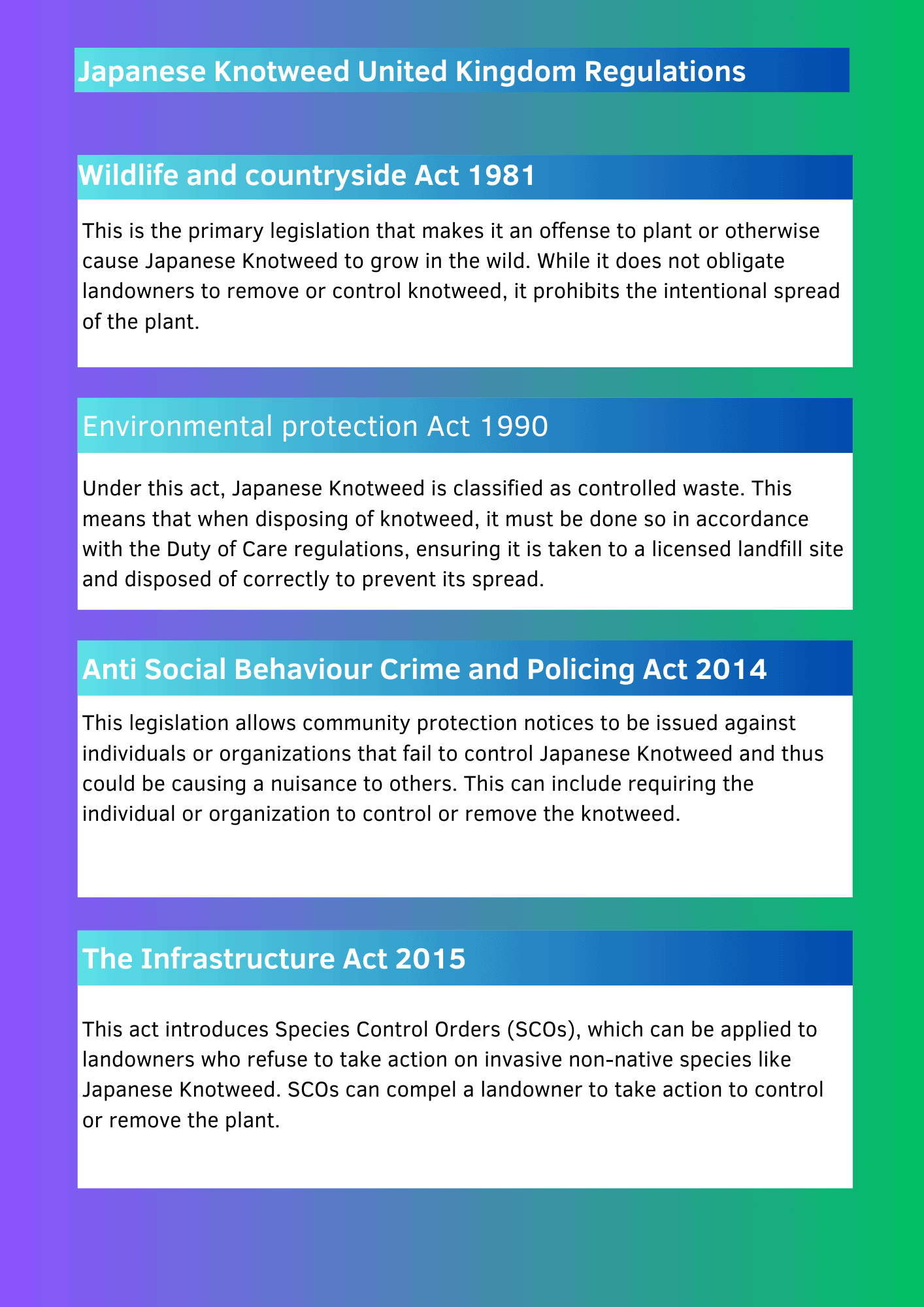
If the Japanese knotweed survey reveals the presence of Japanese knotweed on your property while selling your house.
The following steps typically involve implementing a treatment plan to effectively manage and eradicate the plant. One common approach is a 5-year treatment plan utilizing herbicides to gradually kill the plant. By starving it of vital nutrients, halting its ability to produce amino cells. Here’s a clear explanation of the treatment plan and the frequency of visits:
Initial Treatment:
The treatment plan typically begins with an initial application of herbicide. This is usually in early summer when the plant is actively growing and most susceptible to treatment. This initial application aims to weaken the plant’s growth and prepare it for further treatment.
Follow-Up Visits in June and September (Years 1-3):
In the first three years of the treatment plan, follow-up visits are scheduled for June and September. These visits are crucial for monitoring the treatment progress and applying additional herbicides as needed. The June visit targets the plant during its peak growing season. The September visit ensures continued control as the plant prepares for dormancy.
Follow-Up Visit in September (Years 4-5):
In the fourth and fifth years of the treatment plan, the frequency of visits is reduced to once per year, typically in September. By this stage, the Japanese knotweed should be significantly weakened. However, continued monitoring and treatment are essential to prevent any resurgence.
Continued Monitoring and Maintenance:
Even after the five-year treatment plan. Ongoing monitoring and maintenance may be necessary to ensure the Japanese knotweed does not regrow. This may involve periodic inspections and additional herbicide applications if any new growth is detected.
Professional Assistance:
Engaging a qualified and experienced specialist company is essential to carry out the treatment plan and oversee the eradication process. They will have the expertise to select the most appropriate herbicides, apply them safely and effectively, and provide guidance on long-term management strategies.
Free Ten-Year insurance-backed Guarantee with your Treatment Plan.
A 10-year insurance-backed guarantee (IBG) for a Japanese knotweed treatment plan is a form of assurance. It provided to property owners following the treatment and removal of Japanese knotweed from their property. This Guarantee is designed to cover the cost of any further treatment should the knotweed re-emerge within the guarantee period. It offers peace of mind and financial security to the property owner. Here’s what it typically covers:
Re-treatment of Japanese Knotweed
Suppose Japanese knotweed reappears within ten years after initial treatment. In that case, the guarantee ensures that additional treatments will be carried out at no extra cost to the property owner. This is crucial because knotweed can be resilient, and its complete eradication may require multiple treatments over several years.
Remedial Work
In some cases, the guarantee may cover the cost of remedial work if the re-emergence of knotweed causes damage to the property that was previously treated. This aspect depends on the terms and conditions of the specific guarantee.
Transferability
The guarantee is usually transferable to new owners if the property is sold. This mskes it a valuable asset in real estate transactions. It assures potential buyers that the property is protected against the costs associated with the return of Knotweed.
Professional Standards
Guarantees are often backed by companies that adhere to professional standards and are recognized by industry bodies. This ensures that qualified professionals carry out the treatment plan using approved methods.
Compliance with Legal and Environmental Regulations
The guarantee ensures that any treatment or removal of Knotweed complies with current legal and environmental regulations, protecting the property owner from potential legal issues associated with improper handling or disposal of this invasive species.
When you choose me to conduct your survey, you’re selecting a PCA-accredited surveyor who adheres strictly to the Property Care Code of Practice. With comprehensive qualifications in Japanese knotweed treatment and expertise in building and construction. I am equipped to assess the presence of Japanese Knotweed and evaluate any potential structural damage it may have caused. although such occurrences are very rare. The Japanese Knotweed survey report you’ll receive is meticulously crafted to meet the standards expected by all lenders.
FAQ: Can I still sell my property if I have Japanese knotweed?
Yes you can still sell your house if you have Japanese Knotweed within your boundary. Click play on the video opposite to learn more about what’s required
Can you confirm when is the best time too spray Japanese Knotweed ? Click play on the video opposite to learn when we spray Japanese Knotweed
Is it true, If I have Japanese Knotweed will it reduce the value of my property by 20%?
Click play on the video opposite to learn more
Ive been told it is very difficult to kill Japanese Knotweed is it true that it can take longer than 5 years to kill the plants
Click play on the video opposite to learn more
My friend told me that the Japanese knotweed will not grow from the seeds it produces, can you tell me if this is true?
Click play on the video opposite to learn more
Everything associated with Japanese knotweed seems to be negative. Is Japanese knotweed good for anything at all?
Click play on the video opposite to learn more.
The number one myth about Japanese Knotweed
Japanese Knotweed cannot grow through concrete.
The belief that Japanese Knotweed can grow through solid concrete is exaggerated but not entirely without basis. Japanese Knotweed is a highly resilient and vigorous plant known for exploiting weaknesses and cracks in structures, including concrete. Here is a more detailed explanation:
Growth Through Weaknesses
Japanese Knotweed does not grow through solid, undamaged concrete. However, it can exploit any pre-existing cracks, gaps, or weaknesses in concrete to push through. This is because the plant’s rhizomes (underground stems) are very strong and can grow extensively underground. If they encounter a weak spot in concrete, such as a crack or a joint, they can grow into these spaces and over time push the concrete apart.
Misconceptions
The notion that Japanese Knotweed can grow through solid concrete might have arisen from observations of the plant emerging through cracks in concrete slabs, pavements, and walls. However, this results from the plant exploiting existing damage, not causing the initial damage to intact, solid concrete.
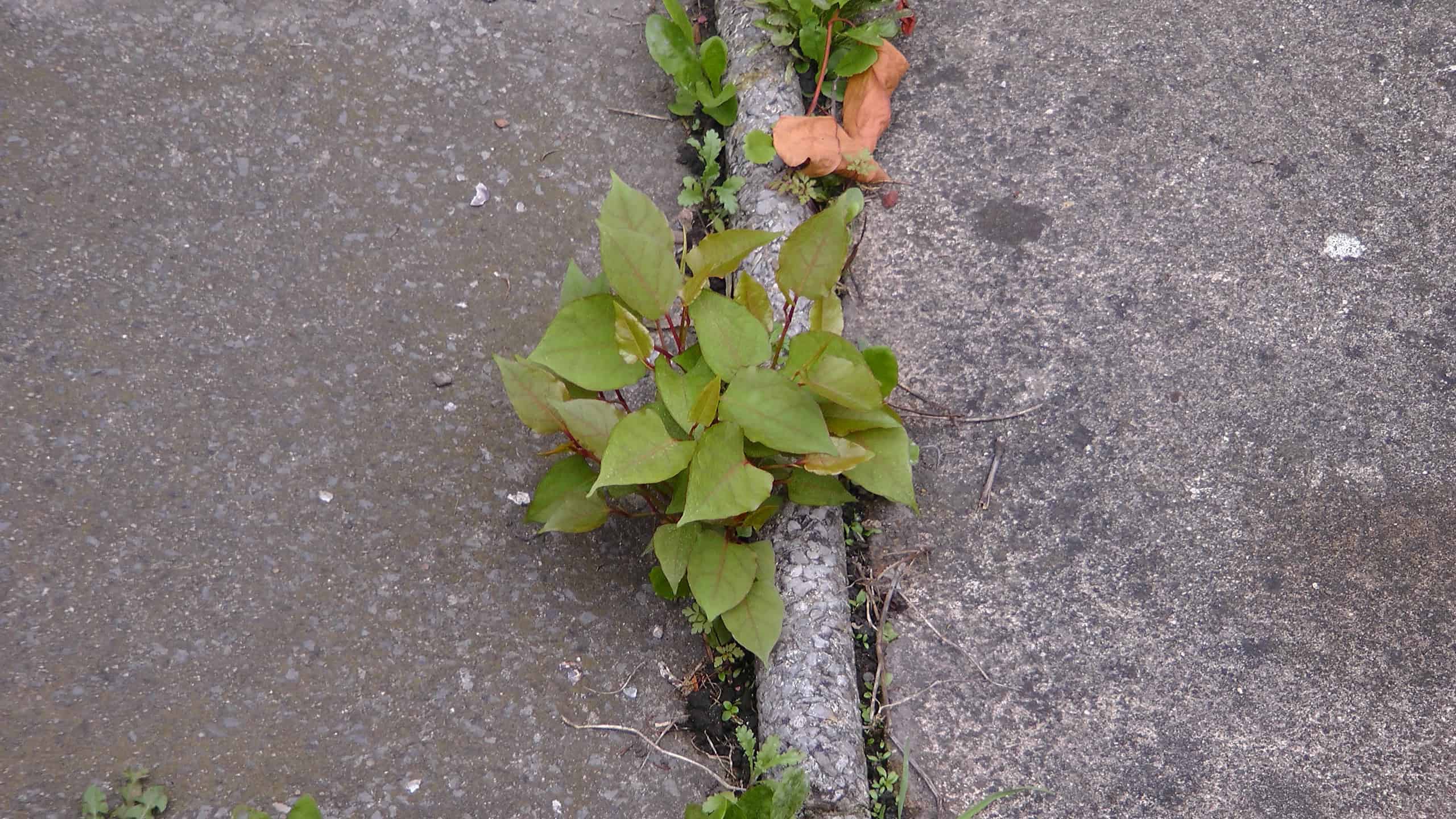

Structural Damage
While Japanese Knotweed is unlikely to penetrate solid, intact concrete. Its ability to exploit and worsen pre-existing cracks can lead to structural damage over time. This is particularly concerning for buildings, foundations, and infrastructure where integrity is compromised, leading to potentially costly repairs.
Management
Due to its resilience and ability to spread managing Japanese Knotweed often requires professional intervention. This might include chemical treatment, physical removal of the rhizomes, or a combination of methods and ongoing monitoring to prevent re-growth.
How is Japanese Knotweed spread?
It is primarily spread through human activity and natural dispersal mechanisms.
Here are the key ways through which it spreads:
Japanese knotweed (Fallopia japonica) is notorious for its resilience and ability to spread through multiple pathways. Beyond waterways, railways, animal activities, and fly-tipping, there are several other significant vectors that facilitate its distribution:
Human Activities:
The construction, development, and maintenance of land can contribute to the spread of Japanese knotweed. Earth-moving activities, such as digging and the transportation of soil that contains rhizome fragments, can establish new colonies elsewhere.
Garden Waste:
Disposal of garden waste containing Japanese knotweed fragments into compost heaps or over garden fences can lead to new infestations. Homeowners may unknowingly contribute to its spread by attempting to dispose of the plant without understanding how easily it propagates
Root Fragmentation:
Japanese knotweed can spread from very small sections of roots (rhizomes). A piece as small as 0.7 grams can potentially grow into a new plant. This means that any disturbance of the soil containing the plant’s roots, such as by gardening tools or construction equipment, can contribute to its spread.
Natural Dispersal:
While less common compared to vegetative propagation, Japanese knotweed can spread through its seeds, especially in suitable climatic and environmental conditions. However, this method of dispersal is not as effective as the spread through rhizome fragments.
Utility Lines:
The plant can also spread along utility lines, such as water and sewage pipelines, where fragments can be transported through maintenance activities or by the movement of water.
Flood Events: During floods, large quantities of knotweed fragments can be washed away and deposited on new sites downstream. This can lead to the establishment of new infestations in previously unaffected areas.
Effective management and control of Japanese knotweed require awareness of these pathways and implementing strategies that minimize the risk of spreading. This includes following proper disposal protocols, conducting thorough Japanese knotweed surveys before land development, and employing professional eradication services when necessary.
Japanese Knotweed was introduced to the UK in the mid-19th century.
It arrived as an ornamental plant in 1850, admired for its bamboo-like stems and its ability to form dense screens. By the early 20th century, it had escaped into the wild and began to spread uncontrollably across various habitats. Its capacity for rapid growth and spread, coupled with a lack of natural predators in the UK, allowed it to become the invasive species it is known as today.
Japanese Knotweed (Fallopia japonica), originally from East Asia, has become one of the world’s most invasive species.
Here are ten interesting facts about Japanese Knotweed Survey
Rapid Growth: Japanese Knotweed can grow up to 10 cm per day during its peak growth season. This rapid growth rate allows it to quickly dominate ecosystems and outcompete native plants.
Resilient Root System: Its root system, or rhizomes, can extend up to 3 meters in depth and 7 meters in all directions from the parent plant, making it incredibly difficult to eradicate once established.
Structural Damage: The plant can cause significant damage to structures, such as buildings, roads, and pavements, as it exploits cracks and weaknesses in concrete and asphalt.
Economic Impact: The economic impact of Japanese Knotweed is substantial, costing the UK economy an estimated £166 million per year for management and treatment.
Legal Implications: In the UK, it’s not illegal to have Japanese Knotweed on your property, but it is illegal to allow it to spread to neighboring properties. The Environmental Protection Act 1990 includes provisions for handling and disposal of knotweed.
Biological Control Efforts: In some regions, efforts to control Japanese Knotweed have included the introduction of specific pests from its native habitat, such as the Japanese knotweed psyllid (Aphalara itadori), as a form of biological control.
Medicinal Uses: Despite its invasive nature, Japanese Knotweed has been used in traditional Chinese medicine for centuries. It contains resveratrol, a compound also found in red wine, which is believed to have several health benefits.
Difficulty in Eradication: Eradicating Japanese Knotweed requires persistent efforts over several years. Methods include chemical treatment with herbicides, physical removal of rhizomes, and covering the area with impermeable materials to starve the roots.
Environmental Impact: Its dense growth can lead to a reduction in biodiversity as native plants are crowded out, altering habitats for insects, birds, and other wildlife.
Edible Parts: Surprisingly, young shoots of Japanese Knotweed are edible and have been compared to a sour, crunchy rhubarb. They can be used in a variety of dishes, though caution is advised due to its invasive nature.
How wide spread is Japanese Knotweed in the UK ?
Japanese knotweed is extremely widespread in the UK.
It has been reported in every part of the country, from urban areas to the countryside. The plant thrives in a wide range of environments, including roadsides, riverbanks, wastelands, and gardens. It can grow through tarmac and concrete, causing damage to infrastructure, such as roads, buildings, and flood defences.
The exact extent of Japanese knotweed infestations across the UK is difficult to quantify precisely, as it continues to spread and many occurrences are likely unreported. However, it’s estimated that it affects thousands of sites across the country. The Environment Agency of England has described Japanese knotweed as “indisputably the UK’s most aggressive, destructive and invasive plant.”
Efforts to manage and control Japanese knotweed are ongoing, involving both local and national initiatives. Property owners, local councils, and environmental organizations work to identify, report, and treat infestations to prevent further spread. Despite these efforts, the plant remains a significant environmental and economic challenge in the UK.
Well what is Japanese knotweed good for ?
Despite its reputation as a problematic invasive species, Japanese knotweed does have some ecological benefits and uses. They are often overshadowed by the challenges it presents. Here are a few aspects where Japanese knotweed can have positive impacts on the environment and animals:
Erosion Control: The dense growth of Japanese knotweed can help stabilize riverbanks and prevent soil erosion in certain areas. Its root system, which is extensive and robust, can hold soil in place, reducing the impact of flooding and water erosion. However, this characteristic also makes it a challenge to remove and control.
Habitat: Although it tends to outcompete native vegetation, in the absence of more desirable native plants. Japanese knotweed can provide cover and habitat for some wildlife. Certain bird species may use dense stands of the plant for nesting and protection from predators.
Soil improvement, Culinary and Medicinal Uses,
Soil Improvement: There is some evidence to suggest that Japanese knotweed can improve soil quality in contaminated sites through a process known as phytoremediation. Its growth can help to break down pollutants in the soil, making it less toxic and potentially restoring it to a condition where other plants can grow. However, this benefit is specific and does not offset the overall negative impact of the plant on ecosystems.
Culinary and Medicinal Uses: Although not directly beneficial to the environment or animals, Japanese knotweed is edible and has been used in traditional medicine. It is a source of resveratrol, an antioxidant that has been linked to various health benefits. The young shoots can be cooked and eaten, and the plant has been used in traditional Asian medicine for centuries.
Despite these potential benefits, the overall impact of Japanese knotweed on non-native environments like the UK is overwhelmingly negative. It threatens biodiversity by outcompeting native plants, damaging buildings and infrastructure, and requiring significant resources to manage and control. The balance of its ecological role is therefore considered detrimental in regions where it is an invasive species.
Despite its reputation as a problematic invasive species, Japanese knotweed does have some ecological benefits and uses. They are often overshadowed by the challenges it presents. Here are a few aspects where Japanese knotweed can have positive impacts on the environment and animals:
Pollinators: Japanese knotweed flowers in late summer and early autumn, a period when few other plants are in bloom. This makes it an important source of nectar for bees and other pollinating insects during these times. Its abundance can help support local bee populations, which are crucial for pollination and the health of ecosystems.
Unveiling the Hidden Invader: The Importance of a Japanese Knotweed Survey
In the verdant landscapes of properties across the country
A hidden invader lurks. Japanese Knotweed, an insidious plant with a voracious appetite for growth, has entrenched itself as a formidable foe to homeowners and prospective property buyers alike. The importance of conducting a thorough Japanese Knotweed survey cannot be overstated, especially if you suspect the presence of this invasive species on your property or one you are considering purchasing.
Japanese Knotweed has the notorious ability to cause significant structural damage to properties. Its strong, relentless roots can penetrate foundations, walls, and drainage systems, leading to costly repairs and a decrease in property value. Thus, identifying its presence early on is crucial. This is where a Japanese Knotweed survey comes into play, offering a professional assessment that can save you from future headaches and financial loss.
If you’re wondering whether your property hosts this unwelcome guest, or if you’re eyeing a new purchase but have concerns about Japanese Knotweed, there’s a straightforward solution. You don’t need to be an expert to take the first step. Simply send photos of the suspected plant via WhatsApp or email for a preliminary assessment. This initial contact is a vital part of the Japanese Knotweed survey process, allowing for a quick identification that can pave the way for further action.
During a Japanese Knotweed survey,
Experts meticulously examine the property to assess the extent of any infestation and advise on the best course of action. Whether it’s eradication, management, or simply a case of mistaken identity, a Japanese Knotweed survey provides the clarity and direction needed to tackle the issue head-on.
The convenience of sending photos via WhatsApp or email for an initial evaluation cannot be understated. It offers a swift and accessible means to get expert eyes on your situation, ensuring that your concerns are addressed promptly. This approach to initiating a Japanese Knotweed survey is not only efficient but also reflects the modern ways in which we can tackle traditional problems.
The presence of Japanese Knotweed on a property
Is a matter that requires immediate attention. The significance of a Japanese Knotweed survey in identifying and managing this invasive species is paramount. Whether you’re safeguarding your current property or considering a new investment, the ease of starting this process through WhatsApp or email photo submissions is a testament to the importance of being proactive. Remember, the earlier you act, the better your chances of mitigating the risks associated with Japanese Knotweed. Don’t let this hidden invader take hold; take the first step today and ensure your property’s safety and value for tomorrow.
